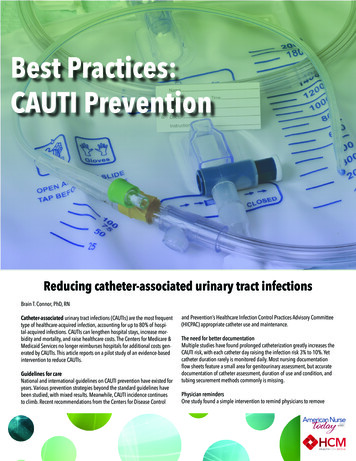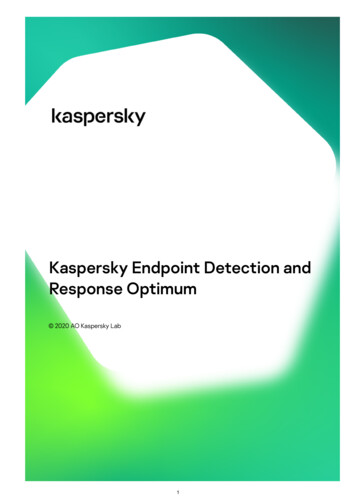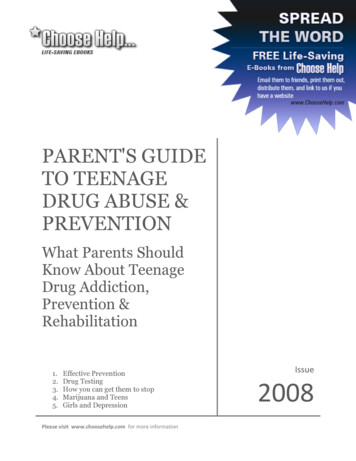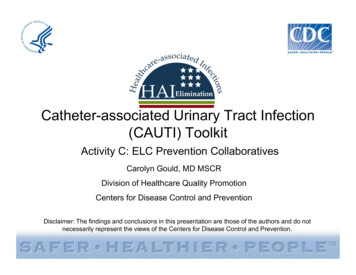
Transcription
Best Practices:CAUTI PreventionReducing catheter-associated urinary tract infectionsBrain T. Connor, PhD, RNCatheter-associated urinary tract infections (CAUTIs) are the most frequenttype of healthcare-acquired infection, accounting for up to 80% of hospital-acquired infections. CAUTIs can lengthen hospital stays, increase morbidity and mortality, and raise healthcare costs. The Centers for Medicare &Medicaid Services no longer reimburses hospitals for additional costs generated by CAUTIs. This article reports on a pilot study of an evidence-basedintervention to reduce CAUTIs.Guidelines for careNational and international guidelines on CAUTI prevention have existed foryears. Various prevention strategies beyond the standard guidelines havebeen studied, with mixed results. Meanwhile, CAUTI incidence continuesto climb. Recent recommendations from the Centers for Disease Controland Prevention’s Healthcare Infection Control Practices Advisory Committee(HICPAC) appropriate catheter use and maintenance.The need for better documentationMultiple studies have found prolonged catheterization greatly increases theCAUTI risk, with each catheter day raising the infection risk 3% to 10%. Yetcatheter duration rarely is monitored daily. Most nursing documentationflow sheets feature a small area for genitourinary assessment, but accuratedocumentation of catheter assessment, duration of use and condition, andtubing securement methods commonly is missing.Physician remindersOne study found a simple intervention to remind physicians to remove
unnecessary catheters can decrease CAUTI rates. Another revealed that prewritten stop orders involving six criteria are acceptable for continued catheter use; if none of the criteria are met, nursesare required to remove the catheter.What nurses can do to reduce CAUTIsTo meet the Joint Commission’s new patient safety goal on CAUTIs, which went into effect January1, healthcare providers must follow evidence-based interventions. The evidence suggests aprimary factor in CAUTI development is catheterization duration. In light of this, a colleague and Ideveloped a UTI prevention (UTIP) bundled protocol of several preventive measures. The bundleprotocol was adapted from a bladder bundle protocol developed by members of the KeystoneCenter for Patient Safety & Quality associated with the Michigan Health & Hospital Association.The UTIP bundle consists of four nursing elements related to catheter use. Our pilot study evaluated the efficacy of combining these elements into a comprehensive bundled protocol and set ofguidelines. The elements are: use of the smallest possible antimicrobial-impregnated catheter (#14 or #16 Fr) daily monitoring of the number of patients on the nursing unit who have catheters, as well asthe type, size, and duration of each catheter use of a specified area in nurses’ bedside charts or the electronic medical record for documenting daily assessment of catheter condition and securement method and potential for catheterremoval development and use of a daily reminder system to alert physicians of the need to evaluate thepatient’s urinary status and consider catheter removal. The charge nurse can stamp a remindermessage in the physician’s progress-notes section of the chart; the reminder also can be discussedduring daily rounds.We also developed a list of appropriate reasons for continuing catheterization based on HICPACguidelines. (See Appropriate reasons for continuing catheterization.) After providing educationfor nurses and physicians, we conducted this pilot study for 3 months. Results showed the UTIPprotocol reduced catheter days by nearly1.5 patient days (from 5.3 to 3.8 days).Nurses’ compliance with all protocolelements was nearly 100%.RecommendationsAs a nurse, you’re largely in control ofyour patients’ catheterization duration.Even if your employer lacks a protocol formonitoring catheter use and reducingduration, you can follow the UTIP bundleprotocol by: always using the smallest catheterpossible and documenting its insertiondate and time taking extreme care when securing thecatheter, and never elevating the tubingor drainage bag above the insertion site monitoring and documenting cath eterization duration and assessing theneed for continuation daily reminding the physician of the cath e terand discussing possible removal if noappropriate reason for continuing catheter use exists.Visit americannursetoday.com for a complete list of references.Brian T. Conner is an assistant professor at the Medical University of South Carolina Collegeof Nursing in Charleston.1
On the road to zero CAUTIs:Reducing urinary catheter device daysCatherine V. Smith, MSN, RN, CCNS, CCRNCatheter-associated urinary tract infections (CAUTIs) are common healthcare-associated infections that can prolong lengths of stay and increase morbidity and mortality. Despite their best efforts, many hospitals continue tostruggle with climbing CAUTI rates. Recognizing inappropriate or prolongedurinary catheterization as a primary risk factor, our team decided to targeturinary-catheter device days as a way to reduce CAUTIs.The specific aim of this quality-improvement initiative was to decrease thenumber of urinary catheters inserted and reduce the time they stayed inplace. Each additional day of indwelling catheterization further increases therisk of developing a CAUTI. We anticipated that by inserting fewer cathetersand removing them earlier, we would decrease CAUTI incidence.Targeted areas for improvement included all five of the noncritical care unitsat our 140-bed community medical center. At the start of this initiative, ourcritical care unit was exceeding at preventing device-associated infections,but our medical-surgical units were seeing a higher-than-expected CAUTIincidence. As we approached 2013, a system-wide task force was poised tointroduce several evidence-based initiatives aimed at reducing CAUTIs.In addition to the task-force solutions intended to standardize the evidence-based processes used with urinary catheters, our team added severalother strategies to enhance our culture of safety and accountability aroundurinary catheters. To monitor our progress, we identified the urinary catheterdevice-utilization ratio (DUR) and actual number of CAUTIs as performancemeasures. Reported monthly, the DUR reflects the proportion of total patients with indwelling urinary catheters. Before our project began, validationstudies were done to ensure the accuracy of DUR reporting. CAUTIs wereidentified and reported by theinfection preventionist.Electronic solutionsIn January 2013, we implemented several electronic solutionsto support our goal of reducingurinary catheter device days. Wealso implemented evidence-basedindications for urinary catheterinsertion and maintenance, basedon guidelines from the HealthcareInfection Control Practices AdvisoryCommittee (HICPAC) and the Association for Professionals in InfectionControl and Epidemiology (APIC),recommended by the system-widetask force for CAUTI prevention.(See Evidence-based indications forindwelling urinary catheters).Time-limited catheterization orders and a nurse-driven protocol for catheterremoval were the primary electronic solutions supporting this initiative. We alsoimplemented: an algorithm for bladder scanning and intermittent catheterization for failureto void electronic alerts to remind physicians and nurses when a temporary catheterhad been in place more than 48 hours revised nursing flowsheets to align our documentation with intervention-bundle recommendations from HICPAC and APIC.These interventions reinforced our commitment to keeping each catheter inplace only as long as medically indicated.Clinician education and trainingRecognizing the importance of clinician education and training toim prove outcomes and prevent complications related to urinary catheters,we partnered with the manufacturer of our urinary cathe ters to develop andimplement a training program aimed at expanding knowledge and improvingcatheter insertion and maintenance competencies. Each unit identified a nursechampion to attend this special training event. In addition to acquiring knowledge and skills, champions learned strategies for sharing the information at theunit level.As part of the training program, skill stations were set up to review competenciesand update techniques. Training emphasized the maintenance bundle and dailyreevaluation of the continued need for a catheter.Nurses aren’t the only clinicians who interact with catheterized patients, so aspecial session was held for non-nursing staff, such as physical therapists andtransport personnel. This contributed to an overall increase in bundle compliance.Improving our culture of safetyThe final and most challenging aspect of this initiative was implementinginterventions aimed at improving our culture of safety and accountability aroundurinary catheters. We recognized this as the most crucial step to sustaining thechange. Our goal was to transform our culture from one where the urinary catheter is considered the norm for certain types of patients to one where it’s seen asan exception.Daily review of all cathetersThe team implemented a daily review of all catheters, including the indicationfor the catheter and patient’s length of stay, at unit-based shift huddles and thedaily hospital-wide safety huddle. Sharing this information in as many forumsas possible provides an opportunity for peer coaching and peer checking. Itencourages nurses to challenge each other about the patient’s ongoing need fora catheter and offers a forum to suggest alternatives.Partnering with physicians also was crucial to the success of our project. To gainphysicians’ participation and input, we incorporated a review of urinary catheters2
at daily interdisciplinaryrounds. This promoted furthercollaboration and teamworkaround this initiative.Finally, we engaged patientsand family members, explaining the risks associated withcatheterization and settingthe stage for early removal atthe time of catheter insertion.One of our best strategies hasbeen to educate patients sothey request early catheterremoval.Redundant auditingprocessesTo monitor the effectivenessof our interventions, we established redundant auditingprocesses to determine compliance with evidence-basedrecommendations forin- sertion and care maintenance bundles. (See Maintenance bundle auditelements.) Clinical nurses on each unit, nurse leaders across the organization, and third-party auditors from the clinical effectiveness departmentparticipate in the audit process. Results are shared at the unit level and withrelevant committees and workgroups. Trends are identified and analyzed tohelp determine solutions.Compliance with each bundle element as well as overall compliance has risensteadily since implementation. For October 2014, the overall urinary catheterbundle compliance rate was 94.7%. A true measure of success for this project hasbeen the steady decline in urinary catheter device days and the actual number ofCAUTIs. (See Statistics tell the story.)Nurses at all levels can influence patient outcomes in a positive way. By focusingon evidence-based prevention strategies and promoting a culture of safety andaccountability, we were able to exceed our goal for reducing urinary-catheterdevice days. We saw a shift in culture when our nurses began leading the wayby advocating for fewer catheter insertions and promoting earlier removal. As aresult, we are well on our way to zero CAUTIs—and your organization can be, too.Editor’s note: For more information about CAUTI, see “ANA CAUTI Reduction Tool”at TI-Reduction-Tool.Selected referencesAssociation for Professionals in Infection Control and Epidemiology. Guide toPreventing Catheter-Associated Urinary Tract Infections. April 2014. apic.org/Resource 8b8bed5b/File/CAUTI 06.pdfCenters for Medicare & Medicaid Services. Catheter-Associated Urinary Tract Infections (CAUTIs). partnershipforpatients.cms.gov/p4p cauti.htmlfectionscauti.html.Gould CV, Umscheid CA, Agarwal RK, Kuntz G, Pegues DA; HealthcareInfection Control Practices Advisory Committee. Guideline for Preventionof Catheter-Associated Urinary Tract Infections 2009. Infect Control HospEpidemiol. 2010;31(4):319-26. df.Institute for Healthcare Improvement. How-to Guide: Prevent Catheter-Associated Urinary Tract Infections. Updated December 2011. ihi.org.Catherine V. Smith is a clinical nurse specialist at Sentara Williamsburg Regional Medical Center in Williamsburg, Virginia.3
Don’t get ‘caught’ in the CAUTI trapTerri Townsend, MA, RN, CCRN-CMC, CVRN-BC, and Pamela Anderson, MSN, RN, APRN-BC, CCRNOne nurse’s story: My father died of a heart attack at age 39, and our mother raised my siblings andme. We were all close to mom; however, as the oldest she and I had a special bond. At age 46 shehad undergone a mitral valve replacement and her aortic valve was replaced about 9 years later.She had survived a cardiac arrest and pulmonary artery rupture. When she was hospitalized withdehydration and acute kidney injury, we believed she would spend some time in the hospital andbe discharged. Her kidney function improved with fluids, and her output was carefully monitoredwith a urinary catheter. She had a history of atrial fibrillation and her rate control medications wereheld. One day, her temperature soared to 102.8 F and her heart rate increased to 130 beats perminute. She developed sepsis, which placed further stress on her pulmonary and cardiovascularsystem. In June 2001 my mother died from complications related to a urinary tract infection. Shewas 61 years old and I still miss her.“It’s just a urinary tract infection. It happens sometimes.” We’ve all heard those words, spoken byboth physicians and nurses. On the surface, it’s a seemingly simple problem, to be remedied witha few doses of an antibiotic, paling in comparison to life-threatening conditions such as respiratoryfailure or cardiac bypass surgery. However, catheter-associated urinary tract infections (CAUTI) canbe just as deadly.A widespread problemEven though the morbidity and mortality of CAUTIs is low compared to other hospital-acquiredinfections, the high use of indwelling urinary catheters causes a large number of urinary tractinfections and deaths. In fact, CAUTIs are the most frequent healthcare associated infection, accounting for 30 % to 40% of infections in hospitalized patients according to data from the Centersfor Disease Control and Prevention. It’s estimated that more than 560,000 nosocomial urinarytract infections occur annually, causing significant morbidity, hospital expenditures, and increasedlength of stay. Mortality from CAUTIs is thought to exceed 13,000 deaths each year. Adherenceto recommended infection control practices could prevent 380,000 infections and 9,000 deathsannually.As a result of the morbidity and mortality linked with CAUTIs, the Joint Commission’s Patient Safety Advisory Group recommended development of a National Patient Safety Goal (NPSG) to focuson the need to follow evidence-based practices to prevent the problem. NPSG.07.06.01 becameeffective in January 2013 and addresses insertion, maintenance, and surveillance of indwellingcatheters. In addition, CAUTIs are deemed a preventable complication by the Centers for Medicareand Medicaid Services (CMS) and associated treatment costs are no longer reimbursable.Pathophysiology of CAUTIThe act of inserting a catheter results in bacterial colonization in the bladder at a rate of 3% perday. By the end of 1 week the catheterized patient’s risk of bacteriuria is 25%. After 30 days, 100%of indwelling catheters are colonized with bacteria. While not all bacteriuria causes symptoms tothe patient, 10% to 24% of these patients will develop a symptomatic CAUTI.The most common bacteria are from the gastrointestinal tract or skin and include: Enterococcus species Escherichia coli Staphylococcus aureus Enterobacter species Coagulase-negative staphylococci Pseudomonas aeruginosa Proteus mirabilis Serratia species Klebsiella pneumonia Candida species4
In the hospital, pathogens can enter the urinary tract due to environmentalcontact or contact with hospital personnel. Hospital-acquired bacteria tendto be more virulent compared to community-acquired bacteria and aremore often resistant to at least one antimicrobial agent. Bacteria enter theurinary tract during insertion, through the catheter lumen itself, or via contact between the outside of the catheter and the urethra. Sixty-six percentof CAUTI’s are due to bacterial entrance via the catheter-urethral interface.The remainder of CAUTI’s is associated with bacterial contamination due tomanipulation of the catheter and drainage system.The indwelling catheter provides a surface for microbial adhesion. Bacteriathat enter the urinary tract produce various adhesions, such as hair-likeprojections to allow them to become firmly attached to the catheter wall.Once attached, the bacteria form biofilm by following the sequence ofmaturation, production of polysaccharides, and dispersion into the localenvironment. Biofilm promotes bacterial growth and reproduction and shelters the bacteria from destruction by antiseptics, antibiotics, and the host’simmune system. Bacteria in this protected environment communicategenetic information with one another, promoting antibiotic resistance andspread of biofilm to other surfaces of the catheter and urinary epithelium.Biofilm can be composed of one or multiple species of bacteria, dependingon the duration of the catheter. These bacteria that live in the biofilm bindto the catheter’s surface, and are virtually impossible to destroy while thecatheter is still in place.The presence of a catheter also causes inflammation and trauma to the urethral and bladder neck mucosa. Both latex and silicone catheters promotethe inflammatory response. If that isn’t enough to cause a CAUTI, inflammation and trauma to the urinary epithelium compromises the patient’s ownability to effectively fight bacteria in the bladder.These physiologic changes result in signs and symptoms such as fever,suprapubic pain, changes in urine characteristics (for example, cloudiness),urgency, and elevated white blood cell count.Treatment and managementIn patients with bacteriuria, removing the catheter (and hence, the sourceof the bacteria) solves the problem. Antibiotic treatment for asymptomaticbacteriuria is not recommended, unless the bacteriuria persists at least 48hours after catheter removal. Before initiating any antibiotic therapy, a urineculture must be obtained to identify the infecting organism and decreasethe likelihood of antimicrobial resistance. The Infectious Diseases Society ofAmerica recommends the following evidence-based treatments: For symptomatic patients without bacteremia, 7 days of antibiotic treatment may be considered if symptoms resolve promptly. For patients with delayed response or with bacteremia, 10 to 14 days oftreatment are recommended. Patients who are not severely ill may benefit from a 5-day course oflevofloxacin. Elderly female patients who develop CAUTI without upper urinary tractsymptoms may benefit from a 3-day antibiotic regimen after the catheter isremoved. Treatment regimens for complicated CAUTI range from 7 to 21 days ofantimicrobial therapy.5Only YOU can prevent CAUTI!The Joint Commission and CMS have developed guidelines for preventionof CAUTIs. CMS identified seven evidence-based guidelines for preventingCAUTI:Insert catheters only for appropriate indications. According to the CDC, asmany as 25% of hospitalized patients have catheters, and not all of themare necessary. The CDC’s Healthcare Infection Control Practices AdvisoryCommittee (HICPAC) recommends indwelling catheters be used for thefollowing conditions: acute urinary retention or bladder obstruction accurate intake and output measurements in critically ill patients perioperative use—urologic procedures, prolonged surgical duration(should be removed in postanesthesia care unit), patients receiving largevolume infusions or diuretics during surgery, need for intraoperativeurinary output monitoring assist healing of open sacral or perineal wounds in incontinent patients prolonged immobilization (eg, unstable spine, multiple traumaticinjuries) end of life comfort care.The HICPAC guidelines state that catheters should not be used as a methodof managing incontinence or for patient or nurse convenience.Remove catheter as soon as possible. The Surgical Care ImprovementProject was initiated in 2006 as a collaboration between The Joint Commission, CMS, Institute for Healthcare Improvement, and the American HospitalAssociation. One of the core measures is to remove urinary catheters onpostoperative day 1 or 2. Length of indwelling time is the single most significant contributing factor in developing a CAUTI. The sooner the catheter isremoved, the less chance of developing biofilm and bacterial colonization.Development of a nurse-driven protocol to remind physicians when catheters are no longer necessary has proven to decrease catheter prevalence.Ensure only properly trained personnel insert and maintain catheters.Understanding the causes of UTI can help eliminate urethral trauma andbacterial transmission during insertion and bacterial colonization while thecatheter is in place.Use strict aseptic technique when inserting the catheter. Hand hygiene,sterile supplies, and proper technique all contribute to a decrease in CAUTI.Use of a catheter securement device prevents movement of the catheterin and out of the urethra, which keeps bacteria from being deposited inthe bladder. Choosing the smallest effective catheter size decreases theincidence of urethral trauma during insertion.Maintain closed drainage system. Use drainage systems with sealed catheter-drainage tubing junctions. Obtain urine specimens aseptically. If thesystem becomes disconnected or leaks, replace the catheter and collectingsystem using sterile equipment and aseptic technique. If the catheter mustbe irrigated to prevent obstruction (ie, postoperative prostate or bladdersurgery), consider using a closed continuous irrigation system.Maintain unobstructed urine flow. Ensure the tubing is not kinked and
the collection bag remains below the bladder at all times. Do not place the collection bag on top of the patient while transporting. Empty the bag regularlyusing a clean container for each patient.Use strict hand hygiene and standard precautions. Wear gloves as appropriate during manipulation of catheter or collection system. Do not use complexdrainage systems (for example, antiseptic cartridges in drainage port). Clean the urinary meatus with soap and water during daily bath. Prevent contact ofthe drainage port with the floor or collecting container.CAUTI Prevention InitiativesThe Hospital Research and Education Trust (HRET) developed 26 Hospital Engagement Networks (HEN) in 2011 to reduce hospital acquired conditions.Their mission was to develop learning collaboratives for hospitals, provide incentives and activities to promote patient safety, conduct training programs,provide technical assistance to help hospitals achieve quality goals, develop a system to monitor hospital progress, and identify high-performing hospitals.CMS awarded 218 million to begin the HEN, applying the Comprehensive Unit-based Safety Program (CUSP) model to disseminate the information andtools to hospitals.Goals of On the CUSP: Stop CAUTI are to reduce mean CAUTI rates by 25% over 18 months, improve patient safety by sharing project tools, and promotestatewide efforts to eliminate healthcare acquired infections. The benefits of participating in the state, regional, and national initiatives include ongoingcoaching and training, access to tools that other organizations have found successful, and sharing of information and data. The ongoing coaching andrequired data submission helps maintain focus on the project, which is essential with the myriad of other initiatives in process.One hospital’s success storyCommunity Hospital Anderson is a 207-bed hospital located in east central Indiana. The medical-surgical management team attended the HEN leadershipconference in May 2012 and joined the On the CUSP: Stop CAUTI initiative through the Indiana Hospital Association in June of 2012. The team formeda multidisciplinary project committee with representation from all nursing units, quality management, and information technology. All nursing staff waseducated on the CAUTI prevention bundle and the importance of reducing healthcare acquired infections. In addition, CAUTI prevention was incorporatedinto the medical-surgical department annual competency fair. Physicians are also required to document the appropriate reason for the catheter when it isordered.Another initiative was to have unit charge nurses complete an audit sheet every day that summarizes the results of the daily assessments that registerednurses (RNs) perform for each patient with a urinary catheter.Daily Urinary Catheter Assessment ToolIf a patient receives an assessment score that indicates the catheter is no longer necessary the order set authorizes the RN to remove the catheter. If thepatient is being transferred from the ICU or emergency department, the RN taking report asks the transferring nurse if the catheter can be removed beforetransfer.As a result of these initiatives, prevalence of CAUTIs in our two medical-surgical units has been reduced by one-half, and we have not experienced a CAUTIin more than 500 days.It’s up to youCatheter-associated urinary tract infections, while traditionally appearing benign, can have devastating consequences for our patients. CAUTI preventionrequires diligence, perseverance, and assertiveness in providing the best patient care. With teamwork, collaboration, and effective communication, we canavoid being “caught” in the CAUTI trap and save patients like the mother at the start of this article.Terri Townsend is a medical-surgical staff educator and Lois Meeker is the medical-surgical clinical director for Community Hospital Anderson inAnderson, Indiana. Pamela Anderson is a nurse practitioner for CORVASC St. Vincent Physician Network in Indianapolis, Indiana.Acknowledgement: The authors would like to dedicate this article to the memory of co-author Pamela Anderson’s mother, who was the subject of theintroductory story.Selected referencesDumont C, Wakeman J. Preventing catheter-associated UTI’s: Survey report. Nursing. 2010;40(12):24-30.Gould CV, Umscheid CA, Agarwal RK, et al. (2010). Guideline for prevention of catheter-associated urinary tract infections 2009. Infect Control Hosp Epidemiol. 2010;31(4):319-26.6
Gray M. Reducing catheter-associated urinary tract infection in the critical care unit. AACN Adv CritCare. 2010;21(3):247-57.Hooton TM, Bradley SF, Cardenas DD, et al. Diagnosis, prevention, and treatment of catheter-associated urinary tract infection in adults: 2009 international clinical practice guidelines from theInfectious Diseases Society of America. Clin Infect Dis. 2010;50(March):625-63.The Joint Commission. Requirement, rationale, reference report: Catheter-associated urinary tractinfections. 2: September 28, 2011.Joint Commission National Patient Safety Goal related to CAUTI. jointcommission.org/assets/1/6/R3 Cauti HAP.pdf.The Joint Commission. Approved: New infection-related national safety goal for 2012. Joint Commission Perspectives. 2011;31(7):6-7.Meddings J, Rogers MA, Macy M, et al. Systematic review and meta-analysis: reminder systemsto reduce catheter-associated urinary tract infections and urinary catheter use in hospitalizedpatients. Clin Infect Dis. 2010;51(5):550-60.Seckel M. Maintaining urinary catheters: What does the evidence say? Nursing. 2013;43(2):63-5.Shekelle PG, Pronovost PJ, Wachter RM, et al. The top patient safety strategies that can be encouraged for adoption now. Ann Intern Med. 2013;158(5):365-8.Umscheid CA, Mitchell MD, Doshi JA, et al. Estimating the proportion of healthcare-associatedinfections that are reasonably preventable and the related mortality and costs. Infect Control HospEpidemiol. 2011;32(2):101-14. 2018 American Nurse Tody. All rights reserved.7
for nurses and physicians, we conducted this pilot study for 3 months. Results showed the UTIP 1 protocol reduced catheter days by nearly 1.5 patient days (from 5.3 to 3.8 days). Nurses' compliance with all protocol elements was nearly 100%. Recommendations As a nurse, you're largely in control of your patients' catheterization duration.










